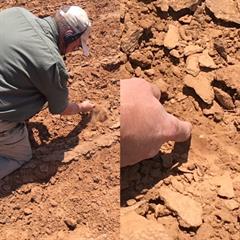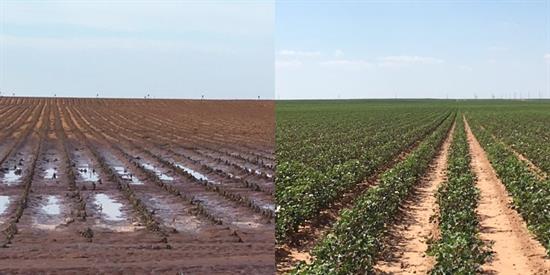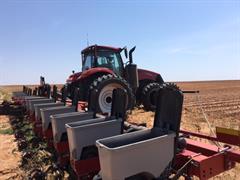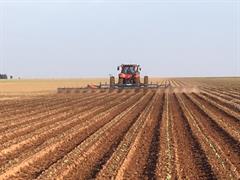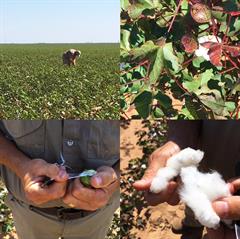Blog
Holladay Farms: Growing Texas Cotton Part II
Washington,
November 29, 2016
Anyone who has driven through cotton country has experienced the pinwheel effect when passing field after field of cotton, watching parallel rows of cotton pass one after another. What most people don’t know is how those fields went from a blank slate of dry, brown dirt to a vast expanse of snow-white cotton. For Shawn Holladay, a fifth-generation cotton farmer in West Texas, it takes daily maintenance of his land to ensure a healthy crop. As we learned from our first conversation with Shawn, he plants his cottonseed in mid-May and early June, during which 14- to 16-hour days are a regular occurrence. We caught up with him before harvest began to check in on the status of his crops.
On the Texas High Plains, weather can be extreme, especially early in the growing season. High winds can blow dirt and sand around tiny, vulnerable cotton plants and burn them. Strong storms with heavy rainfall and hail can pummel a field, flattening rows and washing out newly planted seed. Unfortunately, the first few weeks for the 2016 cotton crop at Holladay Farms were difficult, as high winds and strong storms forced Shawn to replant some of his acreage – twice, in some instances. “There’d be a storm in one area, so we’d move somewhere else and get things fixed, but then a storm would come in there, and we’d move back to where we started. There was just no catching up,” Shawn said. “When you’ve crossed a field three, four, sometimes five times, that typically means you’ve had a lot of rain. We woke up in August and wondered where the last three months of our lives went. That’s usually the sign that you’ve got a really pretty crop.” July and August brought challenges of their own, as 80 mile-per-hour winds swept through some of Shawn’s dryland acreage in mid-summer, and August storms came a little late for maximum yield potential, although the rain was welcome. Temperatures in July were intense, with thermometers surpassing 100 degrees at least 10 days out of the month. Through wind, extreme heat, rain, and hail – sometimes all occurring within the span of a few days – Shawn still expects a pretty good year. One of the most significant challenges facing growers is managing weeds in their fields. Shawn, his wife Julie, and their 4 full-time employees spend much of their time fighting weeds between planting and harvesting. Because cotton is a slow growing plant, and because weeds consume water, cotton growers must implement a well-planned weed control program. Yield and quality are paramount for cotton growers, and weeds can compete for every precious drop of water. Growers want their fields as clean as possible, as weeds also can pose a threat during harvest. A cotton stripper doesn’t necessarily know the difference between a viable plant and a pesky weed, and as it moves through the field, weeds can interfere with the flow of cotton through the harvester, potentially compromising quality and slowing harvest. Growers control weeds through a variety of means. Shawn sprays one application of herbicide across all of his fields, which can take several weeks. Applying herbicide has to be done very precisely to avoid drift and to ensure the wind and other factors are not preventing the herbicide from reaching the targeted areas. Shawn then goes back to spot cultivate infestations and manually hoe any herbicide-resistant weeds remaining. “It’s all hands on deck,” Shawn said. “Everyone, including Julie, is out there pulling weeds. Thankfully, we’ve been able to stay on top of our weed control, but with increasing costs to control resistant weeds, it is becoming very difficult.” Herbicides are a major expense for cotton growers, and at a time of low crop prices and the lack of a safety net for cotton, the financial strain is enough to put many family farms out of business. “Times are not easy for growers right now, especially those with cotton,” Shawn said. “Younger growers, especially, may not have the capital they need to stay in business, but who’s going to continue farming as my generation begins to transition out?” “If we continue current cotton policy, even long-held family farming operations are in jeopardy,” Shawn said. “Crop insurance can only go so far, and it’s helped us through tough times, but it was never designed to deal with anticompetitive trading practices by countries like China and India. However, crop insurance is almost exclusively what a cotton farmer must rely on today.” There is a lot of uncertainty in the life of a farmer. Will Mother Nature play nice? Will crop prices after harvest be high enough to turn a profit, or at least break even? Will the equipment and machinery last another year? Will the United States continue to let other countries heavily influence our policies? These all are things that growers cannot control.
One thing Shawn can control, though, is what he does with what little spare time he has. Once it’s just him and his ATV, he takes a scenic drive through the beautiful canyon on his family’s land, while the worries of the farm melt away, even if only for a few fleeting moments. Surrounded only by streams, brush, wild animal sounds, and a few wind turbines (it is the Plains of Texas, after all) Shawn enjoys winding down the day with these serene views. The canyon is on a farm that Shawn’s father, Grant, worked for many years, and this family land is home to beautiful wildlife; a refuge for them and Shawn’s family alike. These restful moments are especially important because they don’t happen too often. When the Holladays aren’t actively farming, they are involved in many civic and professional activities. Shawn serves as chairman of Plains Cotton Growers, a 41-county cotton producer organization. Julie is a member of The Cotton Board, which promotes agricultural research to help improve yields and profitability. Both Shawn and Julie regularly attend industry meetings locally and across the nation to ensure that growers have a seat at the table, whether discussing policy or promotion of the fiber that drives their family and the entire Texas High Plains region. Shawn also serves the board director representing the Southwest Region for the National Cotton Council. He and Julie attend community events with the Lubbock Chamber of Commerce, the Louise Hopkins Underwood Center for the Arts, and other organizations. As the summer wound down and the bolls swelled with fluffy fiber, Shawn and Grant began checking plants and estimating how mature the seed was by cutting into the boll with a trusty pocket knife. The results of that inspection determined how well the boll would respond to a defoliant and gave them an idea of how far along the crop is. As autumn nears and the temperatures drop, they are busy cleaning up cotton harvesting equipment and preparing for harvest time. Even though Grant retired a couple of years ago, he can’t just stay out of the field – he still actively works in the operation, doing everything from checking pivots to driving tractors to being a part of everyday decisions. He even has his own cotton stripper to use during harvest. Because, you see, farming isn’t just an occupation for the crew at Holladay Farms; it truly is a way of life. With this year’s harvest season nearing the end, we look forward to checking in with Shawn to hear how this year’s crop fared and to find out what happens to his cotton when it leaves his fields.
|

